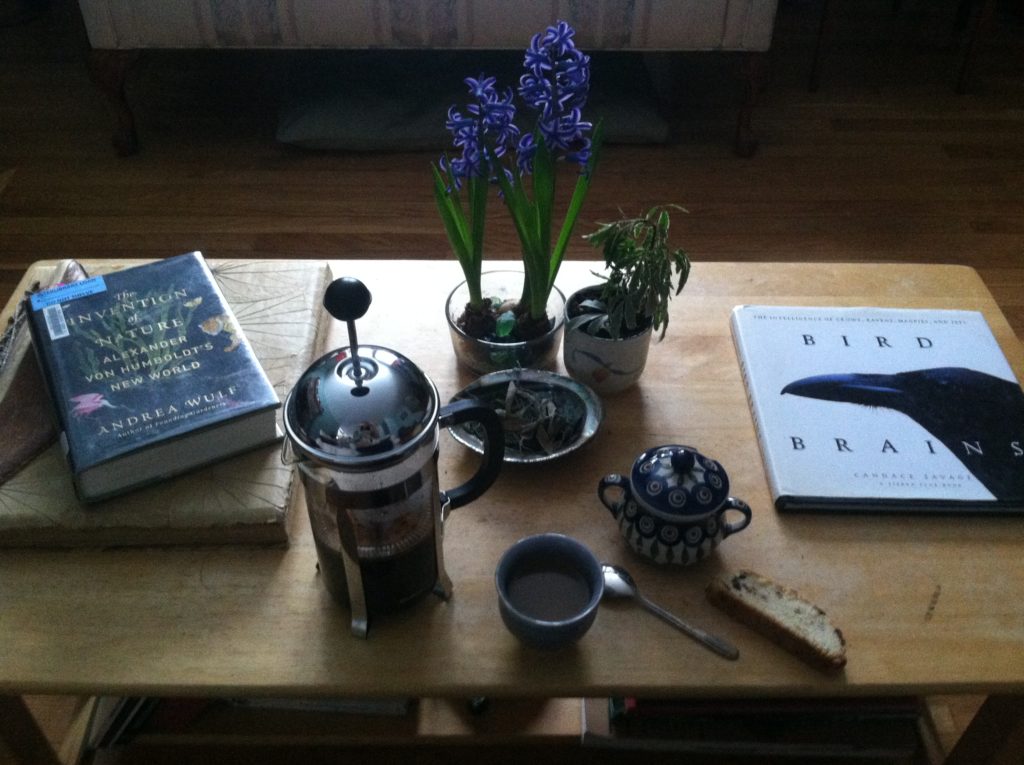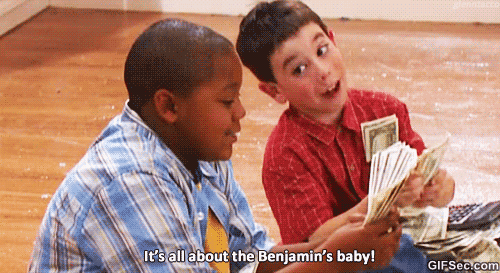Post One: Bartering
I have always been frugal. Some even refer to my living style as cheap (#haters). I don’t update my wardrobe, I buy used over new for most items excluding comestibles, and I could care less if my tech. gadgets are upgraded in line with the latest model. I don’t own a television nor an electronic coffee maker, and until last month, I didn’t possess a dryer (my current housemate bought one so it’s here with her for now). Before the dryer I would hang my clothes on lines strung across the basement (still do for my jeans) and during the warmer months I have an awesome umbrella clothesline that pops up right beside the patio. Line drying may take a bit longer, but it is completely cost effective.
I grow as much food as I’m able to during the summer and can/freeze/dry for the colder months. I charge smaller electronics on my car battery during errands or commutes and I monitor the peak hours of usage for my electric company and plan my washing, trough-filling, and charging of larger electronics on off-hours. (For information on your off-hours/peak hours, contact your local electric provider!)

Today I exchange goods for other goods or services when I can, having recognized early on the strength of a small scale barter economy. When you’re a street hustling adolescent, like I was back in the early 90’s, bartering with candy was a sure shot to way ease into the (sugar-crazed) market of childhood supply and demand.
I recognized early on that not everything has to be purchased with coins or cash and some goods increase in value depending on when you offer them. As a kid, this was a crucial observation and candy, as it turned out, appreciates like gold in the weeks proceeding Halloween.
The day after All Hallows Eve was a bartering playground. Literally. I mean, the playground was crawling with kids hiding under the slides or behind the monkey bars’ platform doling out tootsie rolls for dum-dums or a packet of Nerds for watermelon Blowpops. Different candies had different value, you may recall, and siblings often pooled their loot together.
Those first few weeks of November were mayhem at bus lines and after school programs. Kids had lollipops tucked up their sleeves, Hershey kisses locked in their pencil cases and pixie sticks tucked in the folds of Trapper Keepers; these tots were hustling fast and hard. By mid-November there were still a few of us with decent sweets to barter with and now our Milky Ways could be cashed in for mini-erasers and scented pencils.
I don’t have a sweet tooth now and I didn’t have one growing up. My younger sister would literally house her Halloween candy in under a week and I would stash my own goods to prevent her nicking them. Once that obstacle had been dealt with- “come into my room and die” worked pretty effectively back in those days- I just had to wait for the demand to arrive. It always did and I was never disappointed.
By late November, the candy trade was down to yellow Starbursts and malted Whoppers and the after-school market was becoming stagnant. As Thanksgiving came and went, I turned to my funds. Blessed with a taste for savories over sweets, I still had in my possession all the goods. From my trick-or-treat pillowcase came the Kit-Kats and Airheads that I’d been reserving for this moment. When December arrived, I pulled out the other highly coveted sweets: Gobstoppers, Snickers, Poprocks and Sugar Daddy’s quickly taught me the fundamentals of a supply and demand economics. The demand was high but the supply was low and this girl owned the bartering terrain of Terra Lane. While the rest of the gang was scraping by with candy canes, I was cashing in my Reese’s cups like they were Benjamins.

Black licorice and Heath bars have been and still are my favorite sweet, so it was easy to reserve the stuff that normal kids like as marketable trade items. Kit Kats were worth new pencils, Snickers were worth 3-5 Pogs (not slammers, let’s be real), and one pink Starburst held more value than the mystery 2-pack of the same product; a handful of pinks could get you an entire roll of Lisa Frank iridescent stickers.
I swapped candy for magnifying glasses, mini-notebooks, bouncy balls and once, a pair of swim goggles in March from a kid named Taylor. I’d trade for grab bags of Bugles or pizza Combos as my own parents wouldn’t splurge on those delicacies and on rare occasions, I even swapped for dimes and quarters.
Every once in a while I would combine a couple chocolate bars alongside a box of Nerds and an Airhead in exchange for something exceptional like a Koosh ball or a Beanie Baby. I knew I would have to push the rest of my loot before Valentine Day came with its pink lollipops and conversation hearts, but by holding onto some Babe Ruths and sour strings from Halloween, I was able to score some solid trades even after that Hallmark holiday.
I’d replenish my stock to my best abilities over Valentine’s Day, and later Easter, and then sit on my funds until May when my schoolmates’ baskets were reduced to little more than crinkled paper grass and empty plastic eggs. Then I would haggle those sugar fiends once again. Thus began my early years of recognizing the value behind things that appreciate seasonally.
Flash forward a few decades and while it remains that I don’t have much of a sweet tooth, I am still looking for ways of using what I’ve got already to get me things I’d rather have. Additionally, I have trained myself to only purchase things of worth and continued value. If I like it now and I buy it today, will I still like it next season, next year, or several years from now? Will I be able to resell it? Will it have any worth in a year? If the answer to any of the above posed questions is no, then the purchase is nullified before the cashier can ask if I found everything I was looking for. This brings me to my first rule of shopping: Don’t go if you don’t have a particular item that you need.
If you walk into any shopping center without a defined purpose, you will indubitably find something that you want, Watson. As we know, a want is not a need and so you’re stuck spending your hard earned money on something that doesn’t fill a void. If you’re not missing it, you don’t need it. If you buy it because you want it but don’t actually need it then you, my friend, have just made an empty investment in superfluous consumerist crap. Asking yourself about the functionality of the product in question before making the decision to replace it can save you money and prevent consumerist crap accumulation.
Some examples:
A new sponge to replace the current science experiment living on your sink: need
A new sponge because the one at Target is shaped like Hello Kitty: superfluous consumerist crap
New hand towels because the ones you have are tattered and torn: need
New hand towels because the rainbow farting unicorn print has all but faded on the current ones: superfluous consumerist crap.
A new pair of black heels because the other ones are bent and irreparable: need
A new pair of black heels because the other ones don’t have metal spikes: superfluous consumerist crap (unless those shoes with the spikes are a workplace dress-code requirement in which case, they’re now a business write-off, so go for it).
Get where I’m going here? If you wear heels on a regular basis, I firstly applaud you and secondly suggest you look in your closet and determine how many pairs get worn more than once a week. Separate them from the ones you wear more than once a month and then lastly, designate a category for those you wear once a year.
If you have a pair of heels for each of these categories you probably don’t need to purchase any more heels. Money saved for your nest egg. Those you are only wearing once a year, consider selling or trade with a friend who has also done this exercise and more than likely has some unused heels with which to barter.
Do this with every item of clothing you currently keep in your closet and bureau. If you have bins under your bed that are filled with clothes, I’m thinking you might not miss them if they were suddenly gone. Sell or trade these too. Online sites like thredUP make it easy with a fill-the-box-kit but if you’ve got a Plato’s Closet nearby like we do here in NH, they’ll buy your old brand name items right then and there in person.
In regards to daily linens like hand towels: own one decorative set and reserve it solely for company. When you invite the people you love and care about into your house it is only logical that they judge your abilities, personality, character and wit based entirely on your choice in linen hand towels. Pacify this dilemma by either a.) getting over that delusional misconception or b.) keeping the schmancy towel set tucked away for times when you’re hostin’. The unicorns will always get their limelight in the grand scheme of things and the towels themselves will last significantly longer if not used day in and day out.
As for sponges, I ended up switching to hand-knitted washcloths a few years ago after a coworker gifted them to me. The benefits of using wool-based washcloths far exceed the trial period of getting used to them. Wool washcloths don’t fall apart like sponges and they can be sanitized in the washing machine. #score They cost virtually nothing (old yarn= new towel) and they are biodegradable when you’re totally done with them. I have a scrubber brush for harder to clean messes that can go through the dishwasher or tossed in boiling water like a toothbrush for sanitation, so essentially, the need for sponges (in the sink) has been eliminated in my home.
That said, I do keep a few earth conscious sponges handy, because sometimes it really is easier to sponge up a mess. The sponges I purchase are made with cellulose and for whatever reason they don’t get that nasty smell traditional sponges acquire after a period of use. They also last significantly longer and rarely fall apart. I ditched paper towels eons ago and have rarely missed them since. I’m saving money and reducing my impact on the landfill. Lest we forget, traditional sponges- those pink, yellow, blue and green ones- are made out of plastic. We might throw them away but they are here to stay in the bigger scheme of things.
In the spirit of not making this the longest blog post in the history of the magpie, I ask that you stay tuned for more frugal living and easy $$ saving ideas. As always, thanks for reading the idle thoughts of a scattered mind.
Much love,
-W

As always love your writing style W, and thanks for the tips!